123 books about Global History and 12
start with B
123 books about Global History and 12
123 books about Global History
12 start with B start with B
12 start with B start with B
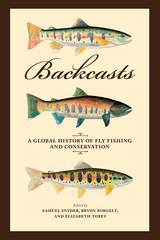
Backcasts
A Global History of Fly Fishing and Conservation
Edited by Samuel Snyder, Bryon Borgelt, and Elizabeth Tobey
University of Chicago Press, 2016
“Many of us probably would be better fishermen if we did not spend so much time watching and waiting for the world to become perfect.”-Norman Maclean
Though Maclean writes of an age-old focus of all anglers—the day’s catch—he may as well be speaking to another, deeper accomplishment of the best fishermen and fisherwomen: the preservation of natural resources.
Backcasts celebrates this centuries-old confluence of fly fishing and conservation. However religious, however patiently spiritual the tying and casting of the fly may be, no angler wishes to wade into rivers of industrial runoff or cast into waters devoid of fish or full of invasive species like the Asian carp. So it comes as no surprise that those who fish have long played an active, foundational role in the preservation, management, and restoration of the world’s coldwater fisheries. With sections covering the history of fly fishing; the sport’s global evolution, from the rivers of South Africa to Japan; the journeys of both native and nonnative trout; and the work of conservation organizations such as the Federation of Fly Fishers and Trout Unlimited, Backcasts casts wide.
Highlighting the historical significance of outdoor recreation and sports to conservation in a collection important for fly anglers and scholars of fisheries ecology, conservation history, and environmental ethics, Backcasts explores both the problems anglers and their organizations face and how they might serve as models of conservation—in the individual trout streams, watersheds, and landscapes through which these waters flow.
Though Maclean writes of an age-old focus of all anglers—the day’s catch—he may as well be speaking to another, deeper accomplishment of the best fishermen and fisherwomen: the preservation of natural resources.
Backcasts celebrates this centuries-old confluence of fly fishing and conservation. However religious, however patiently spiritual the tying and casting of the fly may be, no angler wishes to wade into rivers of industrial runoff or cast into waters devoid of fish or full of invasive species like the Asian carp. So it comes as no surprise that those who fish have long played an active, foundational role in the preservation, management, and restoration of the world’s coldwater fisheries. With sections covering the history of fly fishing; the sport’s global evolution, from the rivers of South Africa to Japan; the journeys of both native and nonnative trout; and the work of conservation organizations such as the Federation of Fly Fishers and Trout Unlimited, Backcasts casts wide.
Highlighting the historical significance of outdoor recreation and sports to conservation in a collection important for fly anglers and scholars of fisheries ecology, conservation history, and environmental ethics, Backcasts explores both the problems anglers and their organizations face and how they might serve as models of conservation—in the individual trout streams, watersheds, and landscapes through which these waters flow.
[more]
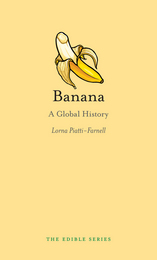
Banana
A Global History
Lorna Piatti-Farnell
Reaktion Books, 2016
Sweet but starchy, soft but toothsome—and so easy to peel they just beg to be devoured—bananas are one of our favorite foods, found everywhere from gas station counters to Michelin star restaurants. Yet for as versatile and ubiquitous as this fruit is today, its history is a turbulent one, entangled in colonial domination, capitalist exploitation, sexual politics, and even horrific violence. Delving into the banana’s past, this book traces the complex circumstances of global modernity that perfectly aligned to grant us, often at tremendous costs, a treat we all now take for granted.
Beginning with the banana’s origins in New Guinea, Lorna Piatti-Farnell follows its pathways to South East Asia, Africa, the Caribbean, and the Americas, binding together a millennium of history into one digestible bunch. Focusing especially on the banana’s recent past, she shows how it rose from a regional staple to a global commodity, on par with coffee and sugar. She examines the ways it has been advertised, sold, and incorporated into popular culture, moving from nineteenth-century medical manuals to cookbooks, songs, slapstick comedy, and problematic figures like Miss Chiquita. Wide-ranging but pocket-sized, Banana is a culinary and cultural account of a peculiar little fruit that is at once the icon of exoticism and one of the most familiar foods we eat.
Beginning with the banana’s origins in New Guinea, Lorna Piatti-Farnell follows its pathways to South East Asia, Africa, the Caribbean, and the Americas, binding together a millennium of history into one digestible bunch. Focusing especially on the banana’s recent past, she shows how it rose from a regional staple to a global commodity, on par with coffee and sugar. She examines the ways it has been advertised, sold, and incorporated into popular culture, moving from nineteenth-century medical manuals to cookbooks, songs, slapstick comedy, and problematic figures like Miss Chiquita. Wide-ranging but pocket-sized, Banana is a culinary and cultural account of a peculiar little fruit that is at once the icon of exoticism and one of the most familiar foods we eat.
[more]
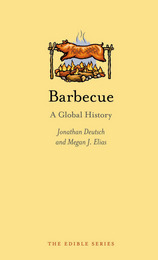
Barbecue
A Global History
Jonathan Deutsch and Megan J. Elias
Reaktion Books, 2014
If there is one thing the United States takes seriously (outside of sports), it’s barbecue. Different in every region, barbecuing is an art, and Americans take pride in their special blend of slow-cooked meat, spices, and tangy sauces. But the US didn’t invent the cooking form, nor do Americans have a monopoly on it—from Mongolian lamb to Fijian pig and Chinese char siu, barbecue’s endless variations have circled the globe. In this history of this red-blooded pursuit, Jonathan Deutsch and Megan J. Elias explore the first barbecues of ancient Africa, the Arawak origins of the word, and define what it actually is.
Traveling to New Zealand for the Maori’s hangi, Hawaii for kalua pig, Mexico for barbacoa de cabeza, and Spain for a taste of bull roast, Barbecue looks at the incredible variety of the food around the world. Deutsch and Elias also discuss barbecue’s status as a masculine activity, the evolution of cooking techniques and barbecuing equipment technology, and the growth of competitive barbecuing in the United States. Rounding out the book are mouthwatering recipes, including an 1877 Minneapolis recipe for a whole roast sheep, a 1942 pork spare ribs recipe from the Ozarks, and instructions for tandoori lamb chops and Chinese roast duck. A celebration of all things smoky, meaty, and delicious, Barbecue makes the perfect gift for backyard grillers and professional roasters.
Traveling to New Zealand for the Maori’s hangi, Hawaii for kalua pig, Mexico for barbacoa de cabeza, and Spain for a taste of bull roast, Barbecue looks at the incredible variety of the food around the world. Deutsch and Elias also discuss barbecue’s status as a masculine activity, the evolution of cooking techniques and barbecuing equipment technology, and the growth of competitive barbecuing in the United States. Rounding out the book are mouthwatering recipes, including an 1877 Minneapolis recipe for a whole roast sheep, a 1942 pork spare ribs recipe from the Ozarks, and instructions for tandoori lamb chops and Chinese roast duck. A celebration of all things smoky, meaty, and delicious, Barbecue makes the perfect gift for backyard grillers and professional roasters.
[more]
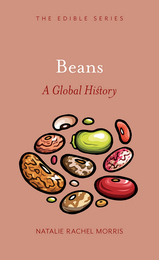
Beans
A Global History
Natalie Rachel Morris
Reaktion Books, 2020
Beans are considered a basic staple in most kitchen cupboards, yet these unassuming foodstuffs have a very long history: there is evidence that beans have been eaten for 9,000 years. Whether dried, frozen, or canned, beans have substantial nutritional and environmental benefits, and can easily be made into a wholesome, satisfying meal. From garbanzos to lentils, and from favas to soybeans, Beans: A Global History brings to life the rich story of these small yet mighty edibles. Featuring historic and modern recipes that celebrate the wide variety of bean cuisines, this book speaks to the modern trend for healthy eating, taking readers on a vivid journey through the gastronomical, botanical, cultural, and political history of beans.
[more]
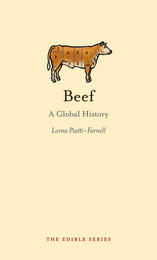
Beef
A Global History
Lorna Piatti-Farnell
Reaktion Books, 2013
Hamburgers, pot roast, stew, steak, brisket—these mouthwatering dishes all have cows in common. But while the answer to the question, “Where’s the beef?” may be, “everywhere,” links to obesity and heart disease, mad-cow disease, and global warming have caused consumers to turn a suspicious eye onto the ubiquitous meat. Arguing that beef farming, cooking, and eating is found in virtually every country, Beef delves into the social, cultural, and economic factors that have shaped the production and consumption of beef throughout history.
Lorna Piatti-Farnell shows how the class status of beef has changed over time, revealing that the meat that was once the main component in everyday stews is today showcased in elaborate dishes by five-star chefs. She considers the place beef has occupied in art, literature, and historical cookbooks, while also paying attention to the ethical issues in beef production and contemplating its future. Featuring images of beef in art and cuisine and palate-pleasing recipes from around the world, Beef will appeal to the taste buds of amateur grillers and iron chefs alike.
[more]
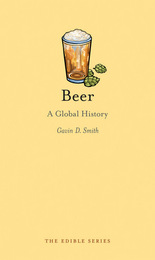
Beer
A Global History
Gavin D. Smith
Reaktion Books, 2014
Pilsners, blonde ales, India pale ales, lagers, porters, stouts: the varieties and styles of beer are endless. But as diverse as the drink is, its appeal is universal—beer is the most-consumed alcoholic beverage in the world. From ballparks to restaurants, bars to brewpubs, this multihued beverage has made itself a dietary staple around the globe. Celebrating the heritage of these popular libations in this entertaining tome, Gavin D. Smith traces beer from its earliest days to its contemporary consumption.
While exploring the evolution of brewing technology and how it mirrors technological changes on a wider economic scale, Smith travels from Mexico to Milwaukee, Beijing, Bruges, and beyond to give a legion of beer brands their due. He then delves into the growth of beer-drinking culture and food-beer pairings and provides information on beer-related museums, festivals, publications, and websites. He also provides a selection of recipes that will be enhanced with the downing of a glass or two of the amber nectar. Containing a wealth of detail in its concise, wonderfully illustrated pages, Beer will appeal to connoisseurs and casual fans alike.
While exploring the evolution of brewing technology and how it mirrors technological changes on a wider economic scale, Smith travels from Mexico to Milwaukee, Beijing, Bruges, and beyond to give a legion of beer brands their due. He then delves into the growth of beer-drinking culture and food-beer pairings and provides information on beer-related museums, festivals, publications, and websites. He also provides a selection of recipes that will be enhanced with the downing of a glass or two of the amber nectar. Containing a wealth of detail in its concise, wonderfully illustrated pages, Beer will appeal to connoisseurs and casual fans alike.
[more]
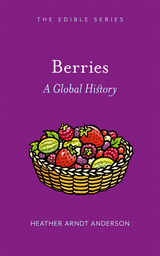
Berries
A Global History
Heather Arndt Anderson
Reaktion Books, 2018
Cheerfully offering themselves to passersby, berries have been juicy staples of the human diet for millennia. They are good luck charms and amulets to some, portents of doom to others. They inspire everything from lip gloss flavors to amusement parks (Knott’s Berry Farm, anyone?)—but eat some varieties and your days will be numbered. We create special bowls and spoons for their presentation and consumption, and without them, there would be no Neapolitan ice cream, and jam would be nothing but a marmalade (though oranges are technically berries, too). However diminutive their stature, berries are of such significance to Northern and Eastern Europeans that picking them in the wild is deemed “everyman’s right,” an act interwoven with cultural identity.
In Berries, Heather Arndt Anderson uncovers the offbeat stories of how humans came to love these tiny, bewildering fruits. Readers meet the inventor of thornless brambles; learn ancient fables and berry-lore; discover berries’ uses in both poisonous witches’ brews and modern superfood health crazes. Featuring a selection of historic and original recipes for berry lovers to try, this is a witty and lushly illustrated ramble through the curious history of our favorite fruits, from interlopers like strawberries (not true berries) to the real deal: tomatoes.
In Berries, Heather Arndt Anderson uncovers the offbeat stories of how humans came to love these tiny, bewildering fruits. Readers meet the inventor of thornless brambles; learn ancient fables and berry-lore; discover berries’ uses in both poisonous witches’ brews and modern superfood health crazes. Featuring a selection of historic and original recipes for berry lovers to try, this is a witty and lushly illustrated ramble through the curious history of our favorite fruits, from interlopers like strawberries (not true berries) to the real deal: tomatoes.
[more]
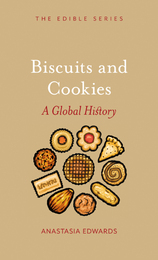
Biscuits and Cookies
A Global History
Anastasia Edwards
Reaktion Books, 2019
What’s your favorite cookie (or biscuit, for any British baking show buffs)? Chocolate chip, ginger spice, or Oreo? Oatmeal-and-raisin, black-and-white, digestive, or florentine? Or do you just prefer the dough? Our choice biscuits and cookies are as diverse as the myriad forms and flavors these chewy treats take, and well they should be. These baked delights have a history as rich as their taste: evidence of biscuit-making dates back to around 4000 BC.
In Biscuits and Cookies, Anastasia Edwards explores the delectable past of these versatile snacks, from their earliest beginnings through Middle Eastern baking techniques, to cookies of Northern Europe in the Middle Ages, and on into the New World. From German lebkuchen to the animal cracker (more than half a billion of which are produced each year in the United States alone), from brownies and sugar cookies in the United States to shortbread and buttery tea biscuits in the United Kingdom, to Anzac and Girl-Guide biscuits in New Zealand and Australia, this book is crammed with biscuit and cookie facts, stories, images, and recipes from around the world and across time. And there’s no need to steal from the cookie jar.
In Biscuits and Cookies, Anastasia Edwards explores the delectable past of these versatile snacks, from their earliest beginnings through Middle Eastern baking techniques, to cookies of Northern Europe in the Middle Ages, and on into the New World. From German lebkuchen to the animal cracker (more than half a billion of which are produced each year in the United States alone), from brownies and sugar cookies in the United States to shortbread and buttery tea biscuits in the United Kingdom, to Anzac and Girl-Guide biscuits in New Zealand and Australia, this book is crammed with biscuit and cookie facts, stories, images, and recipes from around the world and across time. And there’s no need to steal from the cookie jar.
[more]

Brandy
A Global History
Becky Sue Epstein
Reaktion Books, 2014
Made from distilled wine, brandy has a long, noble tradition of refined consumption, but it has also recently experienced a surge in popularity thanks to new cocktail trends. Brandy chronicles the history of this very popular spirit, traveling from medieval alchemists to present-day drink mixologists and exploring brandy’s production and consumption from the Middle Ages to today.
Delving into brandy’s fascinating story, Becky Sue Epstein reveals that many cultures have contributed to the history of the beverage, from the Dutch calling the drink “burnt wine” to the Spanish colonials in Peru and California who produced the first brandies in the New World. She also explores the distillation and aging processes, and she discusses the spirit’s many varieties, including the elegant, amber Cognac and the more overlooked Armagnac. In addition, Epstein offers advice on buying, storing, and serving brandy, while also providing recipes for both classic and new cocktails. Taken neat or mixed in a sidecar, Brandy is a tasty book for both connoisseurs and first-time drinkers to enjoy.
Delving into brandy’s fascinating story, Becky Sue Epstein reveals that many cultures have contributed to the history of the beverage, from the Dutch calling the drink “burnt wine” to the Spanish colonials in Peru and California who produced the first brandies in the New World. She also explores the distillation and aging processes, and she discusses the spirit’s many varieties, including the elegant, amber Cognac and the more overlooked Armagnac. In addition, Epstein offers advice on buying, storing, and serving brandy, while also providing recipes for both classic and new cocktails. Taken neat or mixed in a sidecar, Brandy is a tasty book for both connoisseurs and first-time drinkers to enjoy.
[more]
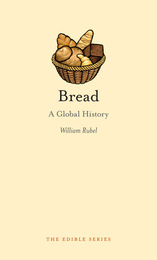
Bread
A Global History
William Rubel
Reaktion Books, 2011
It is difficult to think of a food more basic, more essential, and more universal than bread. Common to the diets of both the rich and the poor, bread is one of our oldest foods. Loaves and rolls have been found in ancient Egyptian tombs, and wheat has been found in pits where human settlements flourished 8,000 years ago. Many anthropologists argue that the ability to sow and reap cereals, the grains necessary for making bread, could be one of the main reasons why man settled in communities, and even today the concept of “breaking bread together” is a lasting symbol of the uniting power of a meal.
Bread is an innovative mix of traditional history, cultural history, travelogue, and cookbook. William Rubel begins with the amazing invention of bread approximately 20,000 years ago in the Fertile Crescent and ends by speculating on the ways in which cultural forces and advances in biotechnology may influence the development of bread in the twenty-first century. Rubel shows how simple choices, may be responsible for the widespread preference for wheat over other bread grains and for the millennia-old association of elite dining with white bread. He even provides an analysis of the different components of bread, such as crust and crumb, so that readers may better understand the breads they buy. With many recipes integrated with the text and a glossary covering one hundred breads, Bread goes well beyond the simple choice of white or wheat.
Here, general readers will find an approachable introduction to the history of bread and to the many forms that bread takes throughout the world, and bread bakers will discover a history of the craft and new ways of thinking that will inspire experimentation.
[more]
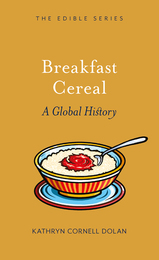
Breakfast Cereal
A Global History
Kathryn Cornell Dolan
Reaktion Books, 2023
A global history of breakfast cereal, from the first grain porridges to off-brand Cheerios.
Simple, healthy, and comforting, breakfast cereals are a perennially popular way to start the day. This book examines cereal’s long, distinguished, and surprising history—dating back to when, around 10,000 years ago, the agricultural revolution led people to break their fasts with wheat, rice, and corn porridges. Only in the second half of the nineteenth century did entrepreneurs and food reformers create the breakfast cereals we recognize today: Kellogg’s Corn Flakes, Cheerios, and Quaker Oats, among others. In this entertaining, well-illustrated account, Kathryn Cornell Dolan explores the history of breakfast cereals, including many historical and modern recipes that the reader can try at home.
Simple, healthy, and comforting, breakfast cereals are a perennially popular way to start the day. This book examines cereal’s long, distinguished, and surprising history—dating back to when, around 10,000 years ago, the agricultural revolution led people to break their fasts with wheat, rice, and corn porridges. Only in the second half of the nineteenth century did entrepreneurs and food reformers create the breakfast cereals we recognize today: Kellogg’s Corn Flakes, Cheerios, and Quaker Oats, among others. In this entertaining, well-illustrated account, Kathryn Cornell Dolan explores the history of breakfast cereals, including many historical and modern recipes that the reader can try at home.
[more]
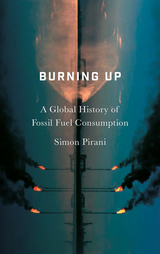
Burning Up
A Global History of Fossil Fuel Consumption
Simon Pirani
Pluto Press, 2018
Coal, gas, and oil have powered our societies for hundreds of years. But the pace at which we use them changed dramatically in the twentieth century: of all the fossil fuels ever consumed, more than half were burnt up in the past fifty years alone, the vast majority of that within a single generation. Most worrying of all, this dramatic acceleration has occurred against the backdrop of an increasingly unanimous scientific consensus: that their environmental impact is devastating and potentially irreversible.
In Burning Up, Simon Pirani recounts the history of the relentless rise of fossil fuels in the past half century, and lays out the ways in which the expansion of the global capitalist economy has driven it forward. Dispelling common explanations that foreground Western consumerism, as well as arguments about unsustainable population growth, Pirani offers instead an insightful intervention in what is arguably the crisis of our time.
In Burning Up, Simon Pirani recounts the history of the relentless rise of fossil fuels in the past half century, and lays out the ways in which the expansion of the global capitalist economy has driven it forward. Dispelling common explanations that foreground Western consumerism, as well as arguments about unsustainable population growth, Pirani offers instead an insightful intervention in what is arguably the crisis of our time.
[more]
READERS
Browse our collection.
PUBLISHERS
See BiblioVault's publisher services.
STUDENT SERVICES
Files for college accessibility offices.
UChicago Accessibility Resources
home | accessibility | search | about | contact us
BiblioVault ® 2001 - 2024
The University of Chicago Press









